Diabetes type 2: Dr Zoe Williams discusses high blood sugar risks
When you subscribe we will use the information you provide to send you these newsletters. Sometimes they’ll include recommendations for other related newsletters or services we offer. Our Privacy Notice explains more about how we use your data, and your rights. You can unsubscribe at any time.
Type 2 diabetes would seem relatively innocuous were it not for the threat of rising blood sugar levels. If you have type 2 diabetes, the hormone responsible for regulating the amount of blood sugar in your blood – insulin – is impaired. This poses grave health risks because, although blood sugar supplies the cells with energy, it must be moderated. Consistently high blood sugar levels can unleash a wave of destruction on the body.
Some of the most acute signs of this destruction fall under the category of diabetic neuropathy.
Diabetic neuropathy is a general term for nerve damage caused by consistently high blood sugar levels.
“You can have nerve damage in any part of your body, but nerves in your feet and legs are most often affected,” explains the Centers for Disease Control and Prevention (CDC).
What to look for
According to the CDC, there are three sensations in your feet that indicate blood sugar levels are damaging the nerves.

These are:
- Numbness
- Tingling
- Pain.
“Nerve damage can also lower your ability to feel pain, heat, or cold,” adds the CDC.
How to respond
The primary treatment response for diabetic neuropathy is to bring high blood sugar levels under control.
“This can help to prevent problems from this diabetic complication,” explains Diabetes.co.uk.
DON’T MISS
Covid vaccine side effects: Six emergency symptoms [INSIGHT]
Type 2 diabetes: Gastoparesis is a warning sign [TIPS]
High blood pressure: Three drinks to lower bp [ADVICE]
Diet, exercise or medication may be adjusted to help stabilise blood sugar levels.
In regards to diet, there is technically nothing you cannot eat if you have type 2 diabetes, but you should limit your intake of certain foods.
The ones to watch are carbohydrates because carbs are broken down into glucose relatively fast – this can have a pronounced impact on blood sugar levels.
Not all carbs pose the same level of risk and referring to the glycaemic index (GI) can help you to identify the worst culprits.

The GI is a rating system for foods containing carbohydrates – it shows how quickly each food affects your blood sugar (glucose) level when that food is eaten on its own.
Carbs that are broken down quickly by your body and cause a rapid increase in blood glucose have a high GI rating.
High GI foods include sugar and sugary foods, sugary soft drinks and white bread.
Instead, you should opt for low or medium GI foods, which are broken down more slowly and cause a gradual rise in blood sugar levels over time.

They include:
- Some fruit and vegetables
- Pulses
- Wholegrain foods, such as porridge oats.
To maximise the benefits of eating healthily, you should engage in at least 2.5 hours of activity a week, advises the NHS.
The health body continues: “You can be active anywhere as long as what you’re doing gets you out of breath.”
This could be:
- Fast walking
- Climbing stairs
- Doing more strenuous housework or gardening.
Source: Read Full Article